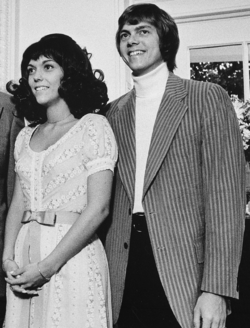The
Carpenters - Top Of The World
Carpenters
- Jambalaya
The
Carpenters Live At The BBC 1971 (Full Show)
The Carpenters Best- Love Songs
https://youtu.be/9CdBQXLd1k8
The Carpenters
From Wikipedia, the free encyclopedia
This article is about the American pop duo. For their third studio album, see Carpenters (album). For other uses, see Carpenter (disambiguation).
| Carpenters | |
|---|---|

Karen and Richard Carpenter at the White House on August 1, 1972.
| |
| Background information | |
| Origin | Los Angeles, California, United States |
| Genres | Pop, soft rock, adult contemporary |
| Years active | 1969–1983 |
| Labels | A&M |
| Associated acts | The Richard Carpenter Trio |
| Website | richardandkarencarpenter.com |
| Past members | |
The Carpenters (officially named Carpenters)[1] were an American vocal and instrumental duo consisting of siblings Karen and Richard Carpenter. Together, they produced a distinctively soft musical style, later becoming one of the best-selling music artists of all time. During their 14-year career, the Carpenters recorded 11 albums, thirty-one singles, five television specials, and a short-lived television series. They were ended in 1983 by Karen's death from heart failure brought on by complications of anorexia. Extensive news coverage surrounding the circumstances of her death increased public awareness of eating disorders.[2][3]
The duo's brand of melodic pop produced a record-breaking run of hit recordings on the American Top 40 and Adult Contemporary charts, and they became leading sellers in the soft rock, easy listening and adult contemporary genres. Carpenters had three No. 1 singles and five No. 2 singles on the Billboard Hot 100 and fifteen No. 1 hits on the Adult Contemporary chart. In addition, they had twelve top 10 singles. To date, Carpenters' album and single sales total more than 100 million units.[4]
...
Musical and lyrical style[edit]
Richard Carpenter was the creative force behind the Carpenter sound.[5] An accomplished keyboard player, composer and arranger, music critic Daniel Levitin called Richard Carpenter "one of the most gifted arrangers to emerge in popular music."[6] In a period when contemporary music was dominated by heavy rock, their smooth harmonies were not in step with the trends of the day.[7] The sound the Carpenters were going for was rich and melodic, along the same vein as the harmonies found in their contemporaries The Beach Boys and the The Mamas & the Papas, but with greater fullness and orchestration.[8] However it was beautiful music to listen to, and very popular. Most of Richard's arrangements were classical in style, with frequent use of strings and occasional brass and woodwind instruments as well. Richard's work with Karen was heavily influenced by the music of Les Paul, whose overdubbing of the voice of partner Mary Ford allowed her to be used as both the lead and harmonizing vocals.[7] By use of multi-tracked recordings, Richard was able to use Karen and himself for the harmonies to back Karen's lead. The overdubbed background harmonies were distinctive to the Carpenters, but it was the soulful, engaging sound of Karen's lead voice that made them so recognizable.
Karen did not possess a powerful singing voice, but when miked closely she conveyed a great deal of feeling. Tight miking required perfect pitch, which came easily to her. Richard Coles, a musician and broadcaster, commented: "No singer is so closely micked up so unforgivingly as Karen Carpenter. That is frightening for singers because the closer the microphone the more unforgiving it is in exposing the weaknesses in a singer's voice."[8] Karen's contralto voice was warm and distinctive. Though her vocal range spanned three octaves, Richard arranged their music to take advantage of the rich quality of Karen's lower range. Commented Richard: "Both Karen and I felt the magic was in her 'chest voice'. There is no comparison in terms of richness in sound, so I wasn't about to highlight the upper voice".[9] Many of the Carpenters' songs are in the keys of D ("You", "There's a Kind of Hush"), E flat ("Only Yesterday"), E ("Hurting Each Other", "Yesterday Once More"), F ("I'll Never Fall in Love Again"), and G ("And When He Smiles", "Reason to Believe", "For All We Know", "You'll Love Me").[10]
Richard is best known for his use of the Wurlitzer electric piano, whose sound he described as "warm" and "beautiful". He also played the grand piano, Hammond organ, synthesizer and even the harpsichord with the band. In the recording studio he often would overdub his acoustic piano parts with a Wurlitzer electric piano to thicken the sound. From the mid-1970s Richard also used Fender Rhodes pianos. While touring he often would have a grand piano as well as both a Rhodes and a Wurlitzer electric piano on stage for different songs.
Karen was an accomplished drummer. Playing drums was her sole role in her initial musical performances with her brother. When it was discovered that she had a beautiful and distinctive voice, she sang in addition to playing the drums. She played the drums on all their pre-1974 songs, and considered herself a "drummer who sang".[11] However Karen's vocals soon became the centerpiece of their performances. At 5'4" in stature, performing behind her drum kit made it difficult for her to be seen. It was soon apparent to Richard and their manager that the audience wanted to see more of Karen. Although unwilling, she eventually agreed to sing the ballads standing, but would return to her drums for the lesser known songs. As the years progressed and demand for Karen's vocals overshadowed all else, she gradually played the drums less. By the time their album A Kind of Hush was released in 1976, Karen did not play the drums at all.[12]

No comments:
Post a Comment